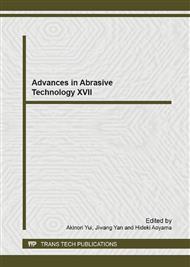p.435
p.441
p.447
p.452
p.458
p.467
p.473
p.479
p.485
Investigation of Grinding Fluid Supply Parameters on Workpiece Surface Integrity
Abstract:
The grinding heat directly affected workpiece surface in the grinding process and it might produce some defects such as crack and burn. Meanwhile wear debris generated in the grinding process could easily embed grinding wheel blowhole and caused clogging and passivation. So it was particular important to avoid defects and improve the grinding workpiece surface integrity effectively. This paper established an incompressible turbulent fluid spray model based on the study of the existing airflow and the grinding fluid distribution in the grinding zone. Then according to different grinding fluid supply parameters established the two-phase gas liquid spray flow model by using CFD(computational fluid dynamics), simulated and calculated the model, compared the mass flow rate of the grinding fluid flow field with different spray distances, heights, speeds and spray angles in the grinding zone and determined the most reasonable spraying jet position. At the last, through researching on the workpiece surface integrity experiment, it provided an experimental basis to determine the most suitable spray jet position and verify the rationality of supply parameters selection.
Info:
Periodical:
Pages:
458-463
Citation:
Online since:
September 2014
Authors:
Price:
Сopyright:
© 2014 Trans Tech Publications Ltd. All Rights Reserved
Share:
Citation:


